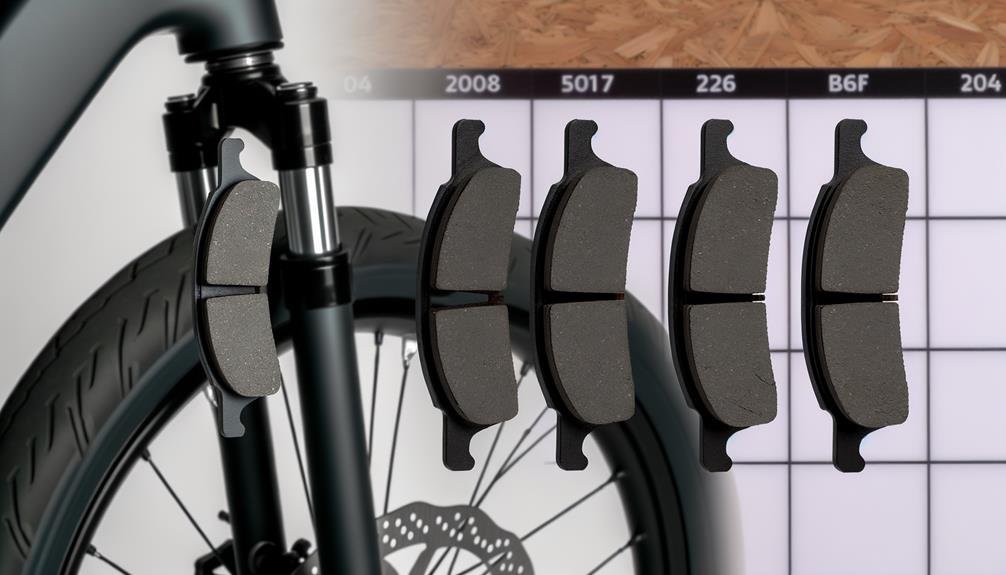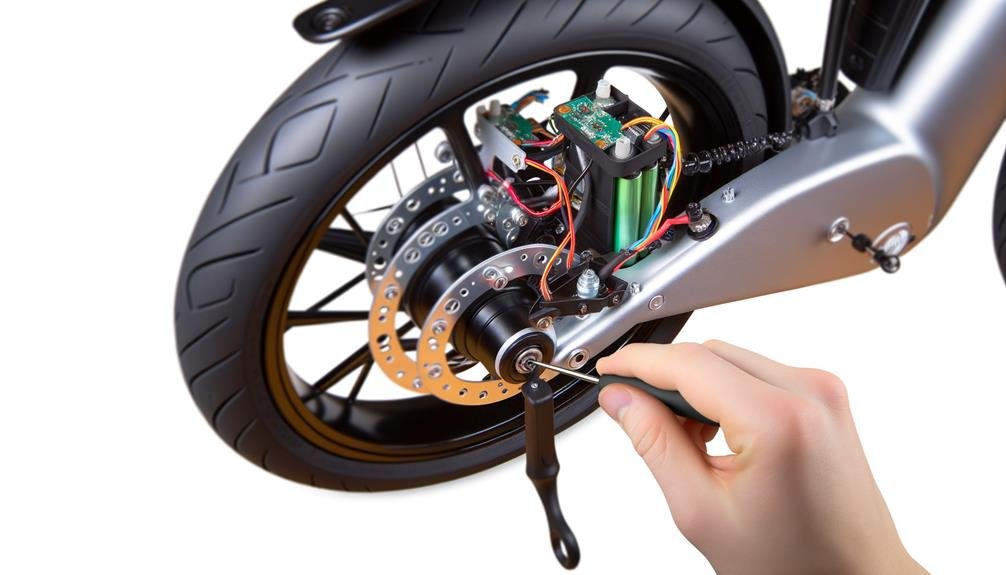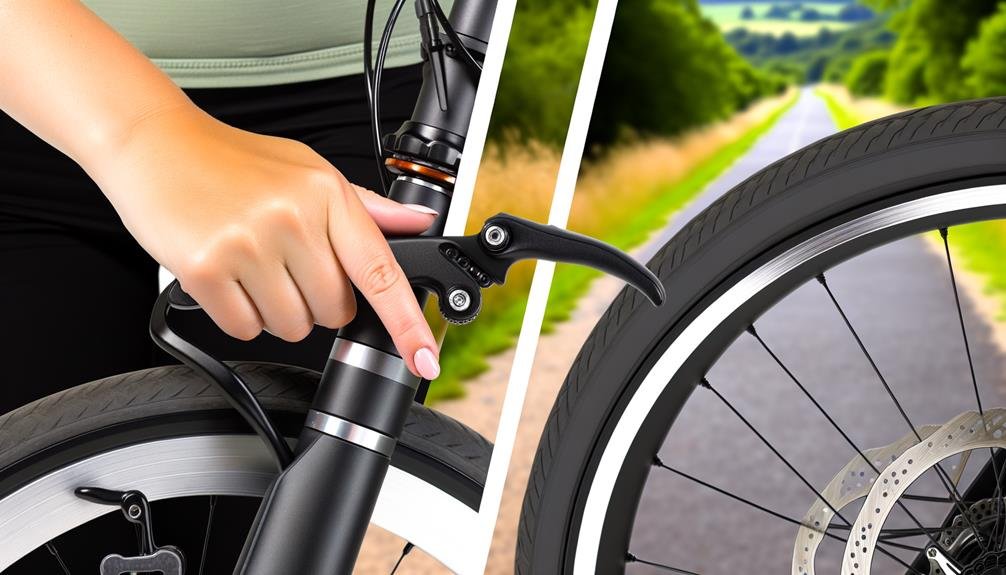Charles Miller is a veteran bike enthusiast with over 12 years of experience dealing with bikes as a mechanic. Despite immense love and expertise for...
Just as a lion is king of the jungle, in the world of ebikes, the one with the most torque reigns supreme. Torque in an ebike is its ability to climb hills and accelerate, making it a crucial factor in performance.
We've been studying, comparing, and testing various models, and it's clear that not all ebikes are created equal in this regard. But which one really stands out?
Which ebike has truly claimed the throne with the highest torque? Well, let's get into the details and see if we can crown a winner.
- Key Takeaways
- Understanding Torque in E-bikes
- Why High Torque Matters
- Choosing a High-Torque E-bike
- Torque Sensors Vs Cadence Sensors
- Battery Capacity and Voltage Analysis
- Importance of Gear System
- Weight and Frame Design Significance
- Testing the Torque of an E-bike
- Frequently Asked Questions
- Conclusion
Key Takeaways
- Torque is crucial for acceleration, hill climbing, and terrain handling in e-bikes.
- High torque enables quick and robust acceleration, effortless hill climbing, and enhances towing capacity.
- Factors like motor type, torque sensor, battery capacity, gear system, weight, and frame design contribute to high torque.
- Choosing a high-torque e-bike involves understanding torque, considering standout features, and joining a community.
Understanding Torque in E-bikes
While torque may seem like a technical term, it's actually a crucial factor in determining an e-bike's acceleration, hill climbing ability, and terrain handling. Understanding torque in e-bikes, therefore, is essential for us as riders.
The torque of an e-bike is measured in Newton meters (Nm), but sadly, this rating isn't consistent across all manufacturers. This inconsistency makes it important for us to comprehend the overall system design rather than just focusing on the torque rating. The type of motor, its positioning, and power delivery efficiency all play significant roles in the torque application of e-bikes. The torque sensor, for example, is a key component that determines how smoothly the motor torque is delivered.
By taking the time to educate ourselves about these drive systems and test driving various models, we can make more informed decisions. High motor torque brings tangible benefits, like quick acceleration and effortless hill climbing. It also enhances towing capacity, off-road performance, and battery usage.
In essence, our understanding of torque directly impacts our e-bike's performance. By embracing this knowledge, we feel a greater sense of belonging in the e-bike community.
Why High Torque Matters
Building on our understanding of e-bike torque, let's explore why high torque is such a crucial feature for optimal e-bike performance.
High torque is the powerhouse behind quick and robust acceleration, helping us keep pace with traffic and navigate challenging terrains with ease. This is why high torque matters when choosing an ebike.
The most torque-rich ebikes are adept at conquering steep inclines, reducing the pedalling effort and making the ride more enjoyable. We love the idea of effortlessly scaling hills, right?
High torque also enhances the towing capacity of our ebikes, a handy feature when we need to carry weighty loads or transport cargo.
A high torque ebike offers efficient battery usage, providing us with longer rides and better energy management. We get more miles for our charge, and that's a big plus for our community.
When we're looking for an ebike with the most torque, we need to consider factors such as motor type, torque sensor, battery capacity, gear system, and the overall weight and frame design. All these elements contribute to why high torque matters and how it can make our ebike experience smoother and more efficient.
Choosing a High-Torque E-bike

When choosing a high-torque e-bike, it's critical to fully grasp what torque means in this context.
We'll introduce you to some top models in the high-torque category and discuss their standout features.
We'll also highlight the advantages that high torque e-bikes offer, arming you with the knowledge to make an informed decision.
Understanding Torque in E-bikes
To fully appreciate the performance and efficiency of e-bikes, it's essential that we delve into understanding torque in e-bikes, a key factor influencing acceleration, hill climbing abilities, and terrain handling. When torque is applied, it gives your e-bike the push it needs to conquer varying terrains, making hill climbing less strenuous.
To further our understanding, let's explore torque's role in an e-bike through the table below:
| Keyword | Description |
|---|---|
| Motor Type | Defines the power and torque applied in e-bikes |
| Power | Influences the bike's climbing ability |
| Torque Sensor | Adjusts the torque based on your pedaling force |
| Test Riding | Helps gauge the e-bike's hill climbing ability |
| Battery Capacity | Affects the sustained torque output and overall performance |
Top High-Torque E-bike Models
Having explored the significance of torque in e-bikes, we can now shift our focus to some of the top high-torque e-bike models, providing insights into making an informed choice.
Biktrix's Juggernaut XD stands out with its powerful XD motor, offering exceptional torque and speeds of 50+ km/h. It's a high-performance e-bike that gives you the thrill of a dirt bike and a solid workout in pedal assist mode. What's more, it's got waterproofed internals for those adventurous rides.
However, remember that factors like algorithm, controller design, and power draw also affect an e-bike's performance. Therefore, it's essential to consider various aspects when choosing the most torque e-bike.
With such high-torque e-bike models, you're not just buying a bike; you're joining a community.
Benefits of High Torque
Let's delve into the numerous benefits of choosing a high-torque e-bike, which range from powerful acceleration to improved off-road performance.
The swift and dynamic acceleration of these ebikes enhances the riding experience, making it more responsive. Their high torque provides effortless hill climbing, ensuring a smoother and more enjoyable ride.
In addition, ebikes with the most torque have an enhanced towing capacity, adding to their versatility. They efficiently handle towing or carrying heavy loads, making them suitable for various tasks.
Moreover, their off-road performance is significantly improved, offering better traction and control in challenging terrains.
Lastly, the efficient battery usage of high-torque motors delivers strong performance while maintaining energy efficiency for longer rides.
The benefits of high torque are indeed numerous and valuable.
Torque Sensors Vs Cadence Sensors
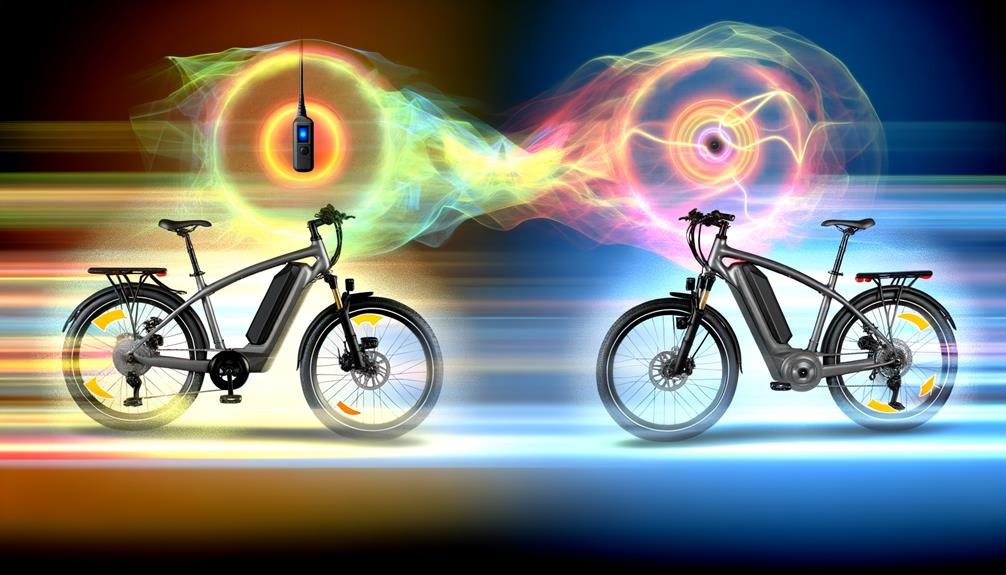
Diving into the differences between torque sensors and cadence sensors, we find that these two components play key roles in how ebikes deliver power to the rider.
Torque sensors measure the actual force or 'torque' a rider applies to the pedals, making the ebike's power delivery more intuitive and responsive. This type of sensor excels in offering a smoother, more natural ride, mirroring the direct relationship between the rider's effort and the ebike's power output.
On the other hand, cadence sensors focus on the pedal's rotation speed, providing power based on pedaling cadence. This mightn't feel as natural or responsive as torque sensors, but they're often more cost-effective, which can be a deciding factor for some riders.
Battery Capacity and Voltage Analysis
In shifting our focus to battery capacity and voltage, we find these elements play a pivotal role in the torque output of an e-bike's motor. By understanding their impact, we're better equipped to compare e-bike battery power and make informed decisions about our rides.
Let's analyze how their interplay determines the performance and efficiency of an e-bike, underlining the importance of these elements in achieving high torque.
Understanding Battery Capacity
To fully appreciate the performance capabilities of an e-bike, it's essential to delve into the intricacies of battery capacity and voltage, two critical components that directly influence speed, torque, and range.
Understanding battery capacity, measured in watt-hours (Wh), provides insight into the e-bike's range and battery life. A higher capacity battery typically translates to longer rides before needing a recharge.
Concurrently, the battery's voltage, measured in volts (V), impacts the bike's acceleration and power. Higher voltage generally results in superior power delivery.
Analyzing these battery options helps us gauge an e-bike's overall performance. Therefore, understanding the relationship between battery capacity and voltage is crucial in selecting an e-bike that meets your specific riding needs.
Voltage Impact on Torque
Understanding how voltage impacts torque is our next step in analyzing an e-bike's performance, as high voltage can significantly boost the bike's acceleration and hill-climbing prowess. It's key to remember when considering which ebike has the most torque.
- Higher voltage equals greater torque, improving acceleration and hill-climbing abilities
- Battery capacity and voltage together influence the torque output
- Torque at low speeds measures the force an e-bike motor can generate
With these points in mind, we can see the importance of voltage and battery capacity in determining an e-bike's performance. It's not just about speed or distance, but the ability to climb and accelerate effectively.
Truly, understanding the voltage impact on torque is essential in the e-bike world.
Comparing Ebike Battery Power
When it comes to comparing ebike battery power, we must delve into a thorough analysis of both battery capacity and voltage, as these factors greatly determine the bike's torque and overall performance.
Battery capacity influences how long an ebike motor can sustain maximum power, while voltage dictates the top speed achievable.
Ebike motors differ in their power capabilities, with some models like the Juggernaut XD and Bafang M620 Ultra leading the pack.
By comparing ebike battery power across different motors on the market, we can assess which offer superior torque and performance.
Keep in mind, higher voltage and capacity don't always translate to better performance.
Other factors, such as controller design and power draw, also play vital roles in an ebike's overall power system.
Importance of Gear System
Why is the gear system so vital to an E-bike's performance, you might ask? The importance of gear system in riding an e-bike is often overlooked, but it plays a crucial role in enhancing your cycling experience.
Primarily, the gear system optimizes pedaling cadence. This implies that you can cycle at your comfortable pace while the system adjusts to maintain your chosen speed. This is especially beneficial in hilly terrains where constant gear shifting is required.
Moreover, the gear system is integral to power delivery, particularly when you're using mid-drive motors. It ensures that power is effectively transmitted from the motor to the wheels, providing a smooth and seamless ride.
Let's delve a little deeper into the importance of gear system:
- It increases efficiency by optimizing pedal power and battery usage.
- It provides flexibility, allowing you to manage varied terrains and speeds easily.
- It enhances the longevity of your e-bike by reducing strain on the motor.
Understanding the gear system won't only maximize your e-bike's performance but also enrich your overall cycling journey.
Weight and Frame Design Significance
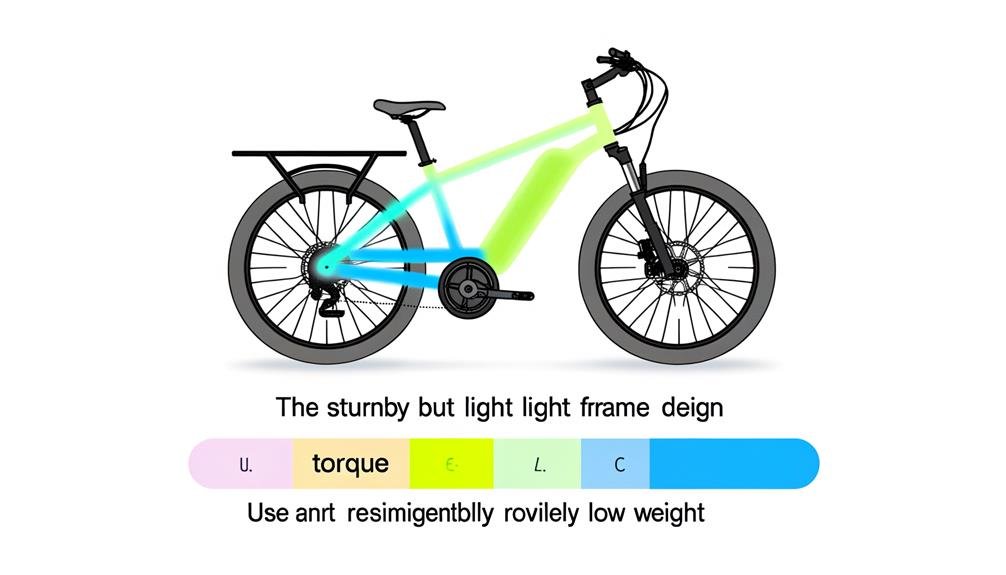
Shifting our focus to the weight and frame design of e-bikes, we find that these aspects significantly influence the bike's overall performance, stability, and handling.
A lighter ebike not only enhances maneuverability, but it also makes handling the bike more manageable, particularly in urban settings or when lifting the bike. This is where the significance of weight comes into play.
Delving into the frame design's significance, we see that it affects the bike's stability and comfort. Different designs cater to varied riding styles and terrains, making it essential to select a frame that suits your needs. The weight distribution of the ebike is another key factor, impacting the bike's balance, responsiveness, and energy efficiency, thus molding the overall riding experience.
Moreover, the choice of frame geometry and material can considerably dictate the comfort and control of the ebike. The right combination can result in a seamless blend of power and control, maximizing the torque output.
In essence, the weight and frame design of an ebike are critical elements to consider for optimal performance and handling. They act as the backbone, supporting and influencing the torque to deliver a superior riding experience.
Testing the Torque of an E-bike
Having examined the weight and frame design's influence on an e-bike's performance, let's now turn our attention to the process of testing the torque of an e-bike to understand its impact on acceleration and hill-climbing ability. The torque of e-bike motors is a key factor in determining the high power performance of an electric bike, which directly affects its speed and maneuverability.
Testing the torque of an e-bike involves several steps:
- Conducting test rides on varied terrains to evaluate acceleration and hill-climbing ability.
- Researching and analyzing reviews to gather information on the e-bike's torque performance.
- Checking the specifications of the motor type and power, the torque sensor or cadence sensor, and battery capacity and voltage.
These steps will give us a comprehensive understanding of the e-bike's torque capabilities.
Remember, a strong torque means a stronger e-bike. So, when you're looking for an electric bike with high power, don't forget to consider the torque. It's not just about speed, but also about how fast you can get going, especially on those steep hills.
We're all in this e-bike journey together, and understanding torque is a crucial part of it.
Frequently Asked Questions
What Is the Best Torque for an Ebike?
We're often asked, "What's the best torque for an ebike?" Torque measurements matter, but the ideal range varies. It's about comparing torque to personal needs. Remember, torque's importance lies in balancing power and control.
What's the Most Powerful Electric Bike?
We believe the most powerful electric bike is the Juggernaut XD. Despite its speed limitations, it has solid battery life, manageable maintenance requirements, and offers significant environmental benefits. It's a top performer in our books.
How Do I Get More Torque on My E-Bike?
We're often asked, "How do I get more torque on my e-bike?" Adjusting your bike's torque and enhancing its power can certainly boost its performance. It's a process that requires careful tweaks and fine-tuning.
How Much Torque Does a 250w Motor Have?
We're analyzing a 250w motor's torque. Motor efficiency, power consumption, torque variations, and speed correlation all factor in. For instance, with optimal efficiency, it might produce less torque but consume less power.
Conclusion
In conclusion, we've realized that the Biktrix Juggernaut XD is the king of torque in the e-bike kingdom. Its superhuman power can conquer any terrain and climb any hill, no sweat.
Analyzing elements like torque sensors, battery capacity, gear systems, and frame design, it's clear that this e-bike is built for the extreme.
So if you're after an e-bike with the most torque, saddle up on the Juggernaut XD – it's truly a beast on wheels.

Charles Miller is a veteran bike enthusiast with over 12 years of experience dealing with bikes as a mechanic. Despite immense love and expertise for his Tacoma, he rides his Trek Ebike more. Anytime you meet him, you’ll either hear him talking about Bikes, or writing about all things bikes and cars on this blog.
More Posts
